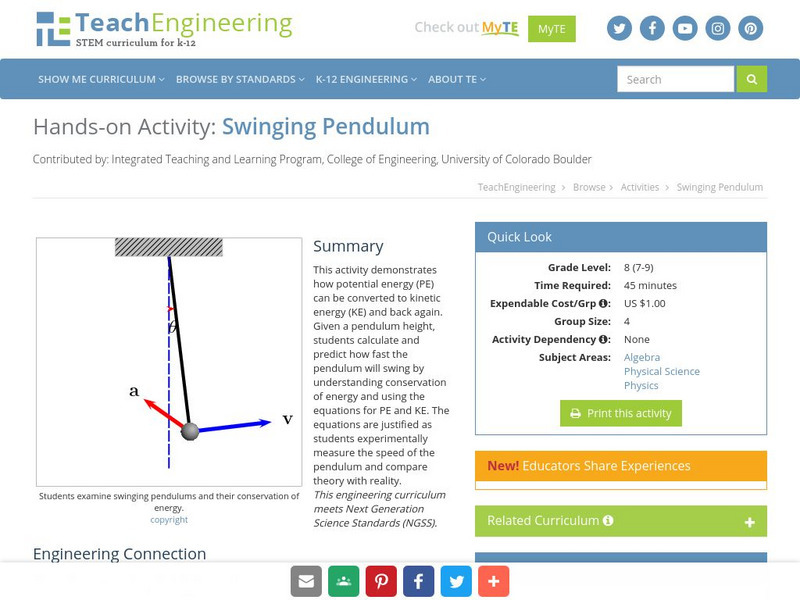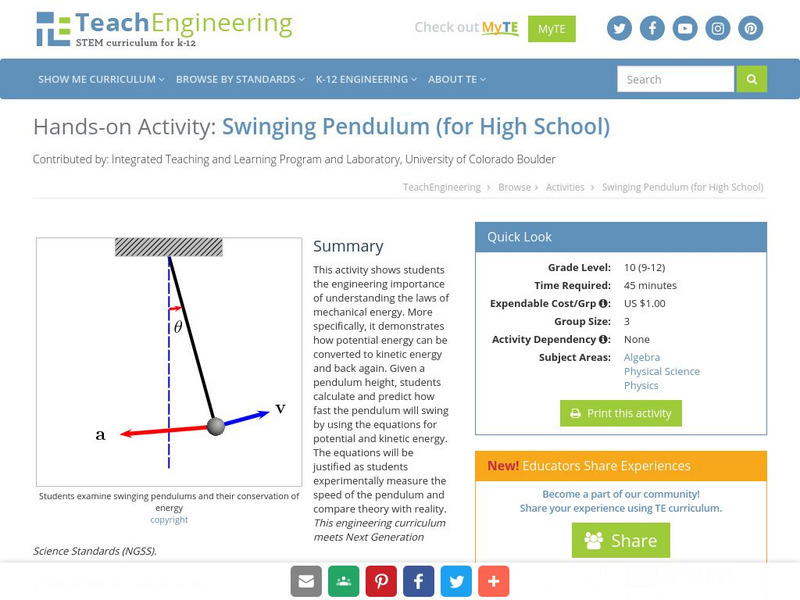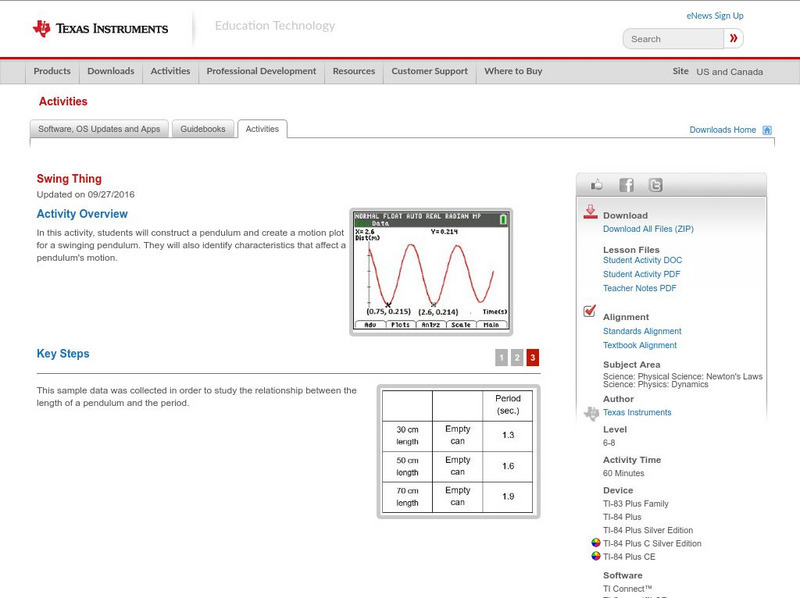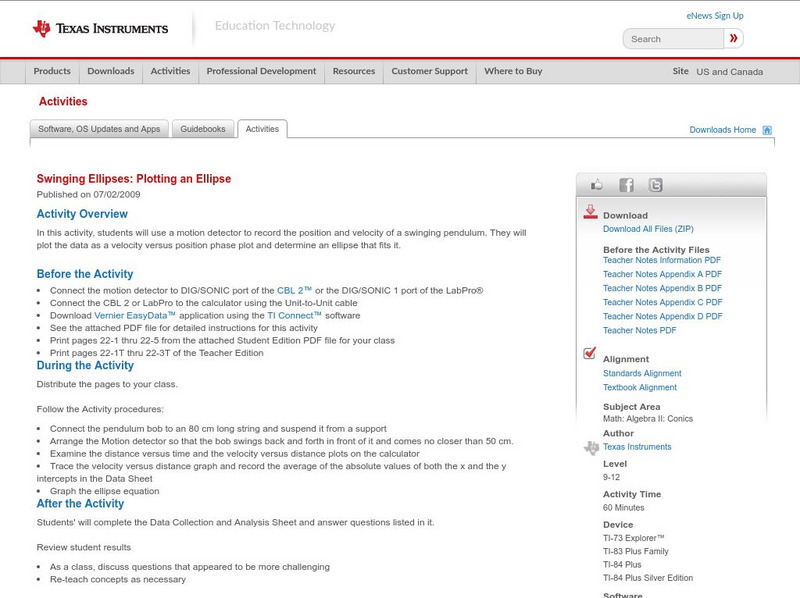Curated OER
Equations With Radical Expressions
Students solve systems of equations with radical expressions. After reading real life situation, they translate the problem into algebraic expressions. As a class, students solve quadratic equations and inequalities by graphing and...
Curated OER
Perpetual Motion
High schoolers are introduced to the concept of Energy Conservation with the example of: Tony Hawk seems to defy the conservation of energy as he keeps reaching new heights on each pass on the halk-pipe. Actually, Tony is supplying the...
Curated OER
Integrated Algebra Practice: Square Roots
In this square roots worksheet, learners calculate the square roots of whole numbers and rational numbers. Seven problems have multiple choice answers. The remaining 13 problems are short answer. One problem involves graphing a function....
Curated OER
Chapter 10 - Objective 4.1 - Distance
In this distance worksheet, students solve equations involving square roots. They use the distance formula to solve four of the ten problems. This one-page worksheet contains ten problems.
Curated OER
Chapter 9 - Objective 4.1 Distance
In this distance worksheet, learners solve radicals. They read story problems, write equations, and compute the speed and or distance an object traveled. This one-page worksheet contains ten problems.
Curated OER
Infinite Geometric Series
In this Algebra II worksheet, 11th graders use their knowledge of infinite geometric series to solve problems such as determine in the sum of a series, solving word problems, and converting repeating decimals to fractions. The one...
Curated OER
Motion of a Bouncing Ball
Twelfth graders complete a unit of lessons on derivatives as they are applied to motion. They observe and discuss demonstrations, conduct an experiment involving a motion sensor, graph and analyze the results, and summarize their findings.
Curated OER
Wave Motion
Students observe and identify various waves. In this wave motion lesson, student use a Slinky, noise, people, and musical instruments to create waves and observe how each type of wave moves.
Curated OER
Acceleration and You
Students discuss and view examples of acceleration. They work together to determine acceleration rates in two ways. They analyze their data and discuss.
Curated OER
Wave Equations
Students manipulate a model of a wave in order to solve the wave equation in 1 dimension. By using a model of a wave on a string the student is able to change the tension, length, and mass of the string as well as fix either end of the...
Curated OER
Kinetic Vs. Potential Energy
Eighth graders listen to a teacher lecture and observe a demonstration of both potential energy and stored energy. After discussing the characteristics and examples of different types of energy, 8th graders make predictions and then...
Curated OER
Basic Units of Time
Students review fundamental concepts of time such as A.M. and P.M. and learn about elapsed time. In this Unit of Time lesson, students review the basics of how to tell time and then are given examples to figure out how much time has...
Curated OER
Simple Harmonic Motion
Students explain the theory of simple harmonic motion (SHM) by performing hands-on, practical application experiments.
Curated OER
Intermediate Critical Reading - Clocks
In these critical reading worksheets, students read the short story about clocks. Students then answer 3 critical reading questions about the passage.
Curated OER
Bean Bag Challenges
Students enhance their knowledge of physical fitness skills as well as related terminology. They explore many challenges using beanbags. Locomotive skills as well as manipulatives and non-manipulatives are involved.
TeachEngineering
Teach Engineering: Swinging Pendulum
This activity demonstrates how potential energy (PE) can be converted to kinetic energy (KE) and back again. Given a pendulum height, students calculate and predict how fast the pendulum will swing by understanding conservation of energy...
TeachEngineering
Teach Engineering: Swinging Pendulum
This activity shows students the engineering importance of understanding the laws of mechanical energy. More specifically, it demonstrates how potential energy can be converted to kinetic energy and back again. Given a pendulum height,...
Science Buddies
Science Buddies: Swing Low: Investigate the Motion of a Pendulum
Kids love to ride the swings at the playground. The back-and-forth motion of a swing demonstrates the physics of a pendulum. In this experiment, you will investigate the factors that affect the speed and duration of a pendulum's swing.
University of Colorado
University of Colorado: Ph Et Interactive Simulations: Pendulum Lab
An interactive simulation that teaches about periodic motion, simple harmonic motion, and conservation of energy. Observe one or two pendulums to determine how the swing is influenced by the length of the string, the mass of the pendulum...
University of Colorado
University of Colorado: Ph Et Interactive Simulations: Pendulum Lab
Manipulate the mass of a weight and the length of string in this interactive pendulum simulation. Change the speed, friction, and gravity to make the pendulum swing change as measurements are displayed on the screen. Younger students can...
Texas Instruments
Texas Instruments: Swing Thing
In this activity, students will construct a pendulum and create a motion plot for a swinging pendulum. They will also identify characteristics that affect a pendulum's motion.
Texas Instruments
Texas Instruments: Tic, Toc: Pendulum Motion
In this activity, students' will use a motion detector to plot the position versus time graph for a swinging pendulum. They will determine the period of the motion and model the position data using a cosine function.
Texas Instruments
Texas Instruments: Swinging Ellipses: Plotting an Ellipse
In this activity, Students can use a motion detector to record the position and velocity of a swinging pendulum. They will plot the data as a velocity versus position phase plot and determine an ellipse that fits it.
Alabama Learning Exchange
Alex: Pendulums Swing Into Motion
This lesson plan will allow students in groups to describe the relationship between energy, work, and force through the use of pendulums. The results will be reported through a graphing activity as well as a paragraph written and printed...























